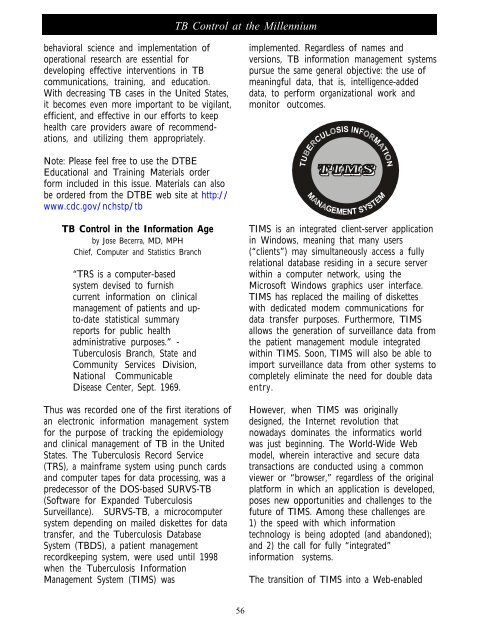CDC History of Tuberculosis Control - Medical and Public Health ...
CDC History of Tuberculosis Control - Medical and Public Health ...
CDC History of Tuberculosis Control - Medical and Public Health ...
You also want an ePaper? Increase the reach of your titles
YUMPU automatically turns print PDFs into web optimized ePapers that Google loves.
ehavioral science <strong>and</strong> implementation <strong>of</strong><br />
operational research are essential for<br />
developing effective interventions in TB<br />
communications, training, <strong>and</strong> education.<br />
With decreasing TB cases in the United States,<br />
it becomes even more important to be vigilant,<br />
efficient, <strong>and</strong> effective in our efforts to keep<br />
health care providers aware <strong>of</strong> recommendations,<br />
<strong>and</strong> utilizing them appropriately.<br />
Note: Please feel free to use the DTBE<br />
Educational <strong>and</strong> Training Materials order<br />
form included in this issue. Materials can also<br />
be ordered from the DTBE web site at http://<br />
www.cdc.gov/nchstp/tb<br />
TB <strong>Control</strong> in the Information Age<br />
by Jose Becerra, MD, MPH<br />
Chief, Computer <strong>and</strong> Statistics Branch<br />
“TRS is a computer-based<br />
system devised to furnish<br />
current information on clinical<br />
management <strong>of</strong> patients <strong>and</strong> upto-date<br />
statistical summary<br />
reports for public health<br />
administrative purposes.” -<br />
<strong>Tuberculosis</strong> Branch, State <strong>and</strong><br />
Community Services Division,<br />
National Communicable<br />
Disease Center, Sept. 1969.<br />
Thus was recorded one <strong>of</strong> the first iterations <strong>of</strong><br />
an electronic information management system<br />
for the purpose <strong>of</strong> tracking the epidemiology<br />
<strong>and</strong> clinical management <strong>of</strong> TB in the United<br />
States. The <strong>Tuberculosis</strong> Record Service<br />
(TRS), a mainframe system using punch cards<br />
<strong>and</strong> computer tapes for data processing, was a<br />
predecessor <strong>of</strong> the DOS-based SURVS-TB<br />
(S<strong>of</strong>tware for Exp<strong>and</strong>ed <strong>Tuberculosis</strong><br />
Surveillance). SURVS-TB, a microcomputer<br />
system depending on mailed diskettes for data<br />
transfer, <strong>and</strong> the <strong>Tuberculosis</strong> Database<br />
System (TBDS), a patient management<br />
recordkeeping system, were used until 1998<br />
when the <strong>Tuberculosis</strong> Information<br />
Management System (TIMS) was<br />
TB <strong>Control</strong> at the Millennium<br />
56<br />
implemented. Regardless <strong>of</strong> names <strong>and</strong><br />
versions, TB information management systems<br />
pursue the same general objective: the use <strong>of</strong><br />
meaningful data, that is, intelligence-added<br />
data, to perform organizational work <strong>and</strong><br />
monitor outcomes.<br />
TIMS is an integrated client-server application<br />
in Windows, meaning that many users<br />
(“clients”) may simultaneously access a fully<br />
relational database residing in a secure server<br />
within a computer network, using the<br />
Micros<strong>of</strong>t Windows graphics user interface.<br />
TIMS has replaced the mailing <strong>of</strong> diskettes<br />
with dedicated modem communications for<br />
data transfer purposes. Furthermore, TIMS<br />
allows the generation <strong>of</strong> surveillance data from<br />
the patient management module integrated<br />
within TIMS. Soon, TIMS will also be able to<br />
import surveillance data from other systems to<br />
completely eliminate the need for double data<br />
entry.<br />
However, when TIMS was originally<br />
designed, the Internet revolution that<br />
nowadays dominates the informatics world<br />
was just beginning. The World-Wide Web<br />
model, wherein interactive <strong>and</strong> secure data<br />
transactions are conducted using a common<br />
viewer or “browser,” regardless <strong>of</strong> the original<br />
platform in which an application is developed,<br />
poses new opportunities <strong>and</strong> challenges to the<br />
future <strong>of</strong> TIMS. Among these challenges are<br />
1) the speed with which information<br />
technology is being adopted (<strong>and</strong> ab<strong>and</strong>oned);<br />
<strong>and</strong> 2) the call for fully “integrated”<br />
information systems.<br />
The transition <strong>of</strong> TIMS into a Web-enabled
















